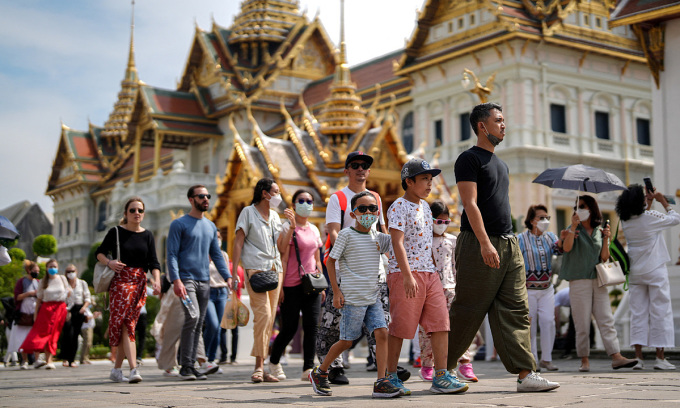Tourism has long been an important pillar of the Thai economy. Before the pandemic, in 2019, the country's tourism revenue was nearly 60 billion USD, accounting for 12% of GDP and 20% of the workforce.
When Covid-19 appeared, due to anti-epidemic measures, tourism decreased, Thailand's growth also decreased. In 2021, international visitors to this country were only 428,000 people, GDP growth was therefore only 1.5%.
As a result, Southeast Asia’s second-largest economy has seen a post-pandemic tourism revival as key as it opens up. The return of Chinese tourists has given it hope, despite weak manufacturing and exports. By 2023, Thailand will be the biggest economic beneficiary of a tourism recovery, according to HSBC.

Thailand's GDP growth and international visitors in 2023 according to forecasts from Nomura Holdings. Photo: Synthesis
To quickly revive the tourism sector, Thailand has continuously come up with ideas and boldly tested them. In March 2020, when Covid-19 was still a major fear when welcoming international visitors, Thailand decided to launch a pilot program to welcome visitors during the pandemic called "The Phuket Sandbox". Initially, visitors from 66 markets came to stay in isolation for 14 days at a hotel on the island.
After a month, the program upgraded to "Phuket Sandbox 7 + 7 Extension", guests stayed 7 days in Phuket then 7 days in some other designated islands before going to their desired destinations. In 3 months, they welcomed 47,610 guests.
By November 1, 2021, Thailand replaced it with the "Test & Go" program, welcoming vaccinated and PCR-tested visitors. Visitors need to quarantine for one night to wait for results and will be free to travel if negative. This policy was quickly successful, in November, Thailand welcomed 91,260 visitors and increased to 230,500 visitors in December. On May 1, 2022, they stopped PCR testing and visitors only need to register for Thailand Pass. To be more open, Thailand Pass was abolished from July 1, 2022.
Along with early resolution of the pandemic, the Tourism Authority of Thailand (TAT) proposed three policies that later became the "trump cards" to help restore tourism. These were increasing the visa exemption period for eligible nationalities from the usual 30 days to 45 days; increasing visa extensions from 15 to 30 days; and increasing flight frequency.
TAT argues that by increasing the maximum length of stay allowed, visitors will stay longer and spend more. They predict that the average tourist will stay five days longer than before. If the average daily visitor spend is 4,000-5,000 baht, this will add about 20,000 baht per visitor to Thailand. That means more money will flow into the economy. By combining the measures, Thailand has succeeded. By 2022, when visitors recover to 11.15 million (above the target of 10 million), economic growth improves to 2.6%. The GDP result is lower than expected due to a fall in exports as global demand weakens. However, the tourism pillar will still maintain a positive growth rate compared to 2021.

Tourists visit the Grand Palace in Bangkok on January 7, 2023. Photo: Reuters
This year, with purchasing power still sluggish, the Thai Retailers Association (TRA) forecasts retail sales to rise 6% to 8% thanks to a recovery in tourism. And according to Kae Pornpunnarath, head of Thai equity research at JP Morgan, an increase in non-resident spending will boost consumer confidence, which remains below average.
"In addition, the Thai government's approval of the 'Shop Dee Mee Khuen' tax rebate scheme - which provides a tax deduction of up to 40,000 baht for goods and services purchased between January 1 and February 15, 2023 - further boosts spending in the short term," said Kae Pornpunnarath.
New ideas to boost revenue continue to emerge. From June 1, international visitors will pay an entry fee of between $4 and $9. When implemented, the country alone will earn more than $115 million this year. Previously, on September 1, 2022, to attract high-income foreigners to stay longer, Thailand introduced a new version of the long-term residence (LTR) visa, with a maximum stay of 10 years. The goal is to attract one million visitors on LTR visas, generating $24.8 billion over five years through their investment and property purchases.
In addition to policies, this year, the Tourism Authority of Thailand applies multi-target marketing strategies to attract tourists from different groups such as health and sports tourists; and "digital nomads", who work remotely via the Internet.
The Thai government is also encouraging local tourism businesses to adopt the Bio-Circular-Green (BCG) economic model, to attract a younger generation of tourists who prioritize sustainable tourism.
According to the British research firm Economist Intelligence, in 2023, tourism is expected to be one of the main sectors contributing to Thailand's GDP growth as the goods export sector will grow more slowly.
"The recovery in tourist arrivals will continue to strengthen in the coming years, which will support jobs and incomes in the tourism and related sectors," the unit assessed.
Ju Ye Lee, an investment banker at Maybank, said China's reopening would not only boost tourism (tourism revenue from Chinese visitors accounted for 3.1% of GDP in 2019) but also help support goods exports - a key factor in slowing growth in the fourth quarter.
Thailand’s industrial sentiment index, measured by the Federation of Thai Industries (FTI), also improved as tourism recovered. The index rose to 96.2 in February 2023, up from 93.9 in January, marking a return to pre-pandemic levels.
Looking at the full year, Nomura Holdings forecasts the Thai economy will grow 4% due to a revival in tourism with foreign arrivals reaching 30 million, higher than the 28 million projected by the National Economic and Social Development Council (NESDC).



































